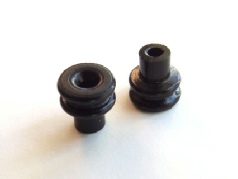Thanks M.H.!
Nice to see some design improvements.
With regard to the subject at hand, I think the answer to whether "to use dielectric grease or to not use dielectric grease" is not black & white.
Several factors need to be considered:
1/ A thorough cleaning of the connection using some type of electrical contact cleaner, followed by a close visual inspection of the terminals. The tech will be able to spot terminals that are suspect & either replace them or sometimes re-work them in order to provide a proper connection. A trick I've seen used over the years is to remove the sealing grommet & carefully re-assemble the connection, paying close attention to the amount of drag felt. Terminals that are weak will provide little to no resistance.
2/ The actual application the grease is important. Filling the cavity of the female terminal of the connector is never a good idea. Careful application of the grease onto the male terminal along with filling the void
around the perimeter of the female terminal(where & if possible) will not cause any issues. Also, understanding the design of the particular connection you are working with. Some will be less forgiving to the amount of grease that are used than others. As you pointed out, the TPS terminals are weak at best so use the grease accordingly.
3/ Limit the amount of times the connector is assembled/disassembled. Certain terminals will lose their tension after unnecessary assembly/disassembly. Thinking that the connection needs to be opened up on a regular basis is a mistake. Once the connector has been inspected & greased there should be no need to open it up again unless for troubleshooting purposes.
I've seen many more issues in equipment using weather proof connectors(Weather Pack / Metri-Pack, Deutsch, Mil-Spec, etc.) that have been due to a lack of grease(or some form of corrosion prevention) than those that have been over-greased. This being due to the imperfect world that we live in where terminal & connector sealing grommets can sometimes leak.
As alternate solution, people may consider the use of this product, Corrosion Block spray:
http://learchem.com/products/corrosion-block.html
We've used it(along with dielectric grease) with success for many years.
I don't like the idea of people misinterpreting this thread as a suggestion to not use dielectric grease(or some form of corrosion prevention). Properly used, it has absolutely no downsides.





